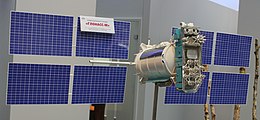Russian military satellite
Kosmos 2500 Glonass-M satellite model
Mission type Navigation Operator Russian Aerospace Defence Forces COSPAR ID 2014-032A[ 1] SATCAT no. 40001[ 1] Website GLONASS status
Spacecraft GLONASS No. 755 Spacecraft type Uragan-M Manufacturer Reshetnev ISS [ 2] Launch mass 1,414 kilograms (3,117 lb) [ 2] Dry mass 250 kg[ 2] Dimensions 1.3 metres (4 ft 3 in) diameter [ 2]
Launch date June 14, 2014, 17:16 (2014-06-14UTC17:16Z ) UTC Rocket Soyuz-2-1b /Fregat [ 2] [ 3] Launch site Plesetsk 43/4 Contractor Russian Aerospace Defence Forces
Reference system Geocentric Regime Medium Earth orbit Semi-major axis 25,519 km (15,857 mi)[ 1] Eccentricity 0.0005[ 1] Perigee altitude 19,129 km (11,886 mi)[ 1] Apogee altitude 19,153 km (11,901 mi)[ 1] Inclination 64.77 degrees[ 1] Period 676.18 minutes[ 1] Epoch 15 June 2014
Kosmos 2500 (Russian : Космос 2500 meaning Space 2500 ) is a Russian military satellite launched in 2014 as part of the GLONASS satellite navigation system. It was the 2,500th satellite to receive a Kosmos designation
This satellite is a GLONASS-M satellite, also known as Uragan-M, and is numbered Uragan-M No. 755.[ 3]
Kosmos 2500 was launched from Site 43/4 at Plesetsk Cosmodrome in northern Russia. A Soyuz-2-1b carrier rocket with a Fregat upper stage was used to perform the launch which took place at 17:16 UTC on 14 June 2014. The launch successfully placed the satellite into a Medium Earth orbit . It subsequently received its Kosmos designation, and the international designator 2014-032A. The United States Space Command assigned it the Satellite Catalog Number 40001.[ 1]
The satellite is in orbital plane 3, in orbital slot 21.[ 4]
See also
References
^ a b c d e f g h i "LIVE REAL TIME SATELLITE TRACKING AND PREDICTIONS: COSMOS 2500 (GLONASS)" . n2yo.com. Retrieved June 15, 2014 .^ a b c d e "Glonass-M spacecraft launch" . TsENKI . April 26, 2013. Archived from the original on March 5, 2016. Retrieved March 27, 2014 .^ a b Stephen Clark (June 14, 2014). "Glonass navigation satellite launched by Soyuz rocket" . Spaceflight Now. Retrieved June 15, 2014 . ^ "GLONASS constellation status, 27.03.2014" . Information-analytical centre, Korolyov, Russia. June 15, 2014. Archived from the original on May 4, 2013. Retrieved June 15, 2014 .
January February March April May June
Kosmos 2500 / GLONASS-M 755 AprizeSat 9, AprizeSat 10, BRITE-Montreal , BRITE-Toronto , BugSat 1 , Deimos-2 , Hodoyoshi 3 , Hodoyoshi 4 , KazEOSat 2 , Perseus-M1 , Perseus-M2 , SaudiSat-4 , TabletSat-Aurora , UniSat-6 (Lemur-1 Tigrisat Flock-1c × 11SPOT 7 , CanX-4 , CanX-5 July August September October November December Launches are separated by dots ( • ), payloads by commas ( , ), multiple names for the same satellite by slashes ( / ).Crewed flights are underlined. Launch failures are marked with the † sign. Payloads deployed from other spacecraft are (enclosed in parentheses).
